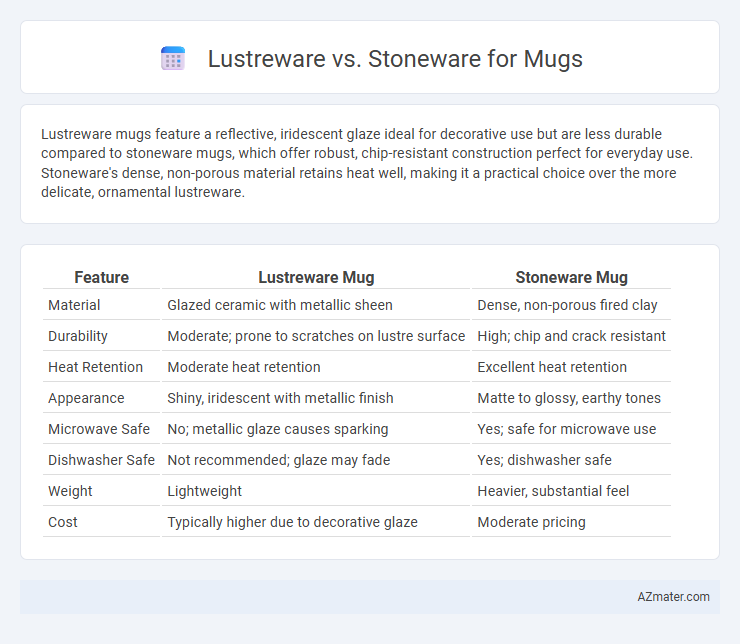Lustreware mugs feature a reflective, iridescent glaze ideal for decorative use but are less durable compared to stoneware mugs, which offer robust, chip-resistant construction perfect for everyday use. Stoneware's dense, non-porous material retains heat well, making it a practical choice over the more delicate, ornamental lustreware.
Table of Comparison
| Feature | Lustreware Mug | Stoneware Mug |
|---|---|---|
| Material | Glazed ceramic with metallic sheen | Dense, non-porous fired clay |
| Durability | Moderate; prone to scratches on lustre surface | High; chip and crack resistant |
| Heat Retention | Moderate heat retention | Excellent heat retention |
| Appearance | Shiny, iridescent with metallic finish | Matte to glossy, earthy tones |
| Microwave Safe | No; metallic glaze causes sparking | Yes; safe for microwave use |
| Dishwasher Safe | Not recommended; glaze may fade | Yes; dishwasher safe |
| Weight | Lightweight | Heavier, substantial feel |
| Cost | Typically higher due to decorative glaze | Moderate pricing |
Introduction to Lustreware and Stoneware Mugs
Lustreware mugs feature a metallic glaze that creates an iridescent, reflective surface, offering a unique and decorative aesthetic prized by collectors and enthusiasts. Stoneware mugs are crafted from dense clay fired at high temperatures, resulting in a durable, non-porous, and chip-resistant beverage vessel ideal for everyday use. Both Lustreware and Stoneware mugs combine artistry with functionality, but they differ significantly in finish, durability, and typical use cases.
What is Lustreware? Key Features and Appeal
Lustreware is a type of pottery distinguished by its metallic glaze that gives mugs a shiny, iridescent finish reflecting various colors under light. Key features include its delicate, shimmering surface often achieved through the application of a metallic film or luster, making each mug visually striking and unique. Lustreware's appeal lies in its decorative elegance and collectible value, contrasting with the more utilitarian and durable nature of stoneware mugs.
What is Stoneware? Durability and Classic Charm
Stoneware is a type of ceramic made from dense clay fired at high temperatures, known for its durability and resistance to chipping and cracking. Its classic charm lies in the natural, earthy textures and muted color palette that complements both rustic and modern kitchen aesthetics. Compared to lustreware, stoneware mugs offer superior sturdiness for everyday use while maintaining timeless appeal.
Visual Aesthetics: Comparing Styles and Finishes
Lustreware mugs exhibit a shimmering, iridescent finish that creates a reflective surface with vibrant, metallic hues, offering a unique and eye-catching aesthetic. Stoneware mugs typically feature a matte or slightly textured finish with earthy tones and natural glazes, emphasizing rustic and organic visual appeal. The contrast between lustreware's glossy, decorative shine and stoneware's subdued, tactile surface highlights distinct stylistic choices for mug design and presentation.
Strength and Durability: Everyday Use Considerations
Stoneware mugs offer superior strength and durability due to their dense, non-porous composition, making them ideal for everyday use and resisting chipping or cracking under regular handling. Lustreware mugs feature a metallic glaze that can be more delicate and prone to wear over time, requiring gentle use and care to maintain their decorative finish. For practical daily use, stoneware provides robust performance and longevity, while lustreware prioritizes aesthetic appeal with moderate durability.
Heat Retention and Insulation Properties
Lustreware mugs feature a metallic glaze that enhances aesthetic appeal but typically offers lower heat retention compared to stoneware due to its thinner walls and less dense material composition. Stoneware mugs provide superior insulation properties, as their thick, porous clay structure retains heat longer, keeping beverages warm for extended periods. For optimal thermal performance in mugs, stoneware is preferred over lustreware due to its durable, heat-retentive qualities.
Maintenance and Care Requirements
Lustreware mugs require gentle hand washing with mild detergents to preserve their metallic sheen, as abrasive cleaners and dishwashers can damage the delicate finish. Stoneware mugs are more durable and typically dishwasher-safe, offering easier maintenance and resistance to chipping and staining. Proper storage avoiding sudden temperature changes helps maintain the longevity of both lustreware and stoneware mugs.
Price Comparison: Affordability and Value
Lustreware mugs generally cost more than stoneware due to their intricate metallic glaze and handcrafted appeal, offering a unique aesthetic that justifies the premium price. Stoneware mugs provide greater affordability with durable, everyday usability and often feature simpler designs, making them a practical value choice for budget-conscious buyers. Evaluating price against longevity and style preferences helps determine the best value between lustreware's decorative luxury and stoneware's cost-effective resilience.
Eco-Friendliness and Manufacturing Impact
Lustreware mugs often involve metallic glazes that require additional firing processes, increasing energy consumption and environmental impact compared to stoneware. Stoneware, made from natural clay fired at high temperatures, offers greater eco-friendliness through durability, reduced waste, and lower energy input during production. Manufacturers favor stoneware for sustainable practices due to its minimal chemical usage and recyclability, making it a greener choice for ceramic mugs.
Which Is Better for Your Mug Collection?
Lustreware mugs feature a distinctive iridescent glaze that adds a shimmering, decorative appeal, making them ideal for collectors seeking aesthetic uniqueness. Stoneware mugs offer superior durability, heat retention, and resistance to chipping, which suits everyday use and practical functionality. Choosing between lustreware and stoneware depends on whether visual elegance or robust performance is the priority for your mug collection.

Infographic: Lustreware vs Stoneware for Mug
 azmater.com
azmater.com